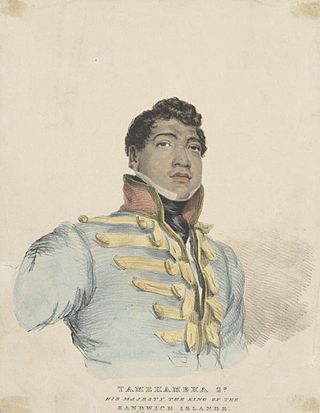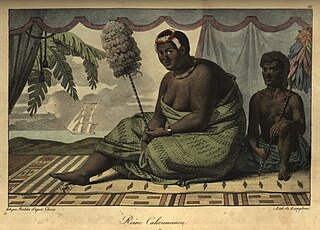In Melanesian and Polynesian cultures, mana is a supernatural force that permeates the universe. Anyone or anything can have mana. They believed it to be a cultivation or possession of energy and power, rather than being a source of power. It is an intentional force.
In the Hawaiian religion, Wākea, the Sky father weds Papahānaumoku, the earth mother. The two are considered the parent couple of the ruling chiefs of Hawaii.
Tapu is a Polynesian traditional concept denoting something holy or sacred, with "spiritual restriction" or "implied prohibition"; it involves rules and prohibitions. The English word taboo derives from this later meaning and dates from Captain James Cook's visit to Tonga in 1777.

Hula is a Hawaiian dance form expressing chant (oli) or song (mele). It was developed in the Hawaiian Islands by the Native Hawaiians who settled there. The hula dramatizes or portrays the words of the oli or mele in a visual dance form.

Kamehameha II was the second king of the Kingdom of Hawaii from 1819 to 1824. His birth name was Liholiho and full name was Kalaninui kua Liholiho i ke kapu ʻIolani. It was lengthened to Kalani Kaleiʻaimoku o Kaiwikapu o Laʻamea i Kauikawekiu Ahilapalapa Kealiʻi Kauinamoku o Kahekili Kalaninui i Mamao ʻIolani i Ka Liholiho when he took the throne.

A lūʻau is a traditional Hawaiian party or feast that is usually accompanied by entertainment. It often features Native Hawaiian cuisine with foods such as poi, kālua puaʻa, poke, lomi salmon, lomi oio, ʻopihi, and haupia, and is often accompanied with beer and entertainment such as traditional Hawaiian music, kanikapila, and hula. Among people from Hawaiʻi, the concepts of "lūʻau" and "party" are often blended, resulting in graduation lūʻau, wedding lūʻau, baby lūʻau, and birthday lūʻau.

Kaʻahumanu was queen consort and acted as regent of the Kingdom of Hawaiʻi as Kuhina Nui. She was the favorite wife of King Kamehameha I and also the most politically powerful, and continued to wield considerable power as co-ruler in the kingdom during reigns of his first two successors.

Ancient Hawaiʻi is the period of Hawaiian history preceding the unification in 1795 of the Kingdom of Hawaiʻi by Kamehameha the Great. Traditionally, researchers estimated the first settlement of the Hawaiian islands as having occurred sporadically between 400 and 1100 CE by Polynesian long-distance navigators from the Samoan, Marquesas, and Tahiti islands within what is now French Polynesia. In 2010, a study was published based on radiocarbon dating of more reliable samples which suggests that the islands were settled much later, within a short timeframe, in about 1219 to 1266.
The aliʻi were the traditional nobility of the Hawaiian islands. They were part of a hereditary line of rulers, the noho aliʻi.

The ʻAi Noa, was a period of taboo-breaking which convulsed the Hawaiian Islands in October 1819. Women were allowed to eat forbidden food and to eat with men; the priests were no longer to offer human sacrifices; the many prohibitions surrounding the high chiefs were relaxed.

A heiau is a Hawaiian temple. Made in different architectural styles depending upon their purpose and location, they range from simple earth terraces, to elaborately constructed stone platforms. There are heiau to treat the sick, offer first fruits, offer first catch, start rain, stop rain, increase the population, ensure the health of the nation, achieve success in distant voyaging, reach peace, and achieve success in war (luakini).

Kalanikauikaʻalaneo Kai Keōpūolani-Ahu-i-Kekai-Makuahine-a-Kama-Kalani-Kau-i-Kealaneo (1778–1823) was a queen consort of Hawaiʻi and the highest ranking wife of King Kamehameha I.
Lilikalā K. Kameʻeleihiwa is a Hawaiian historian, filmmaker, and senior professor at the University of Hawaiʻi's Kamakakūokalani Center for Hawaiian Studies. Her earliest work was published under the name of Lilikalā L. Dorton.

Keaoua Kekua-o-kalani was a nephew of the king Kamehameha I, the chief from Hawaii Island who unified the Hawaiian islands.

Keōua Kalanikupuapaʻīkalaninui Ahilapalapa, sometimes called Keōua Nui was an Ancient Hawaiian noble and the father of Kamehameha I, the first King of united Hawaiʻi. He was progenitor of the House of Keōua Nui. His first name Keoua, or Ke-ao-ua means "the rain cloud" and was given to him by his subjects because of his generosity and his sacred kapu of the heavenly rains.

Hawaiian religion refers to the indigenous religious beliefs and practices of native Hawaiians, also known as the kapu system. Hawaiian religion is based largely on the tapu religion common in Polynesia and likely originated among the Tahitians and other Pacific islanders who landed in Hawaiʻi between 500 and 1300 AD. It is polytheistic and animistic, with a belief in many deities and spirits, including the belief that spirits are found in non-human beings and objects such as other animals, the waves, and the sky. It was only during the reign of Kamehameha I that a ruler from Hawaii island attempted to impose a singular "Hawaiian" religion on all the Hawaiian islands that was not Christianity.

High Chiefess Kapiʻolani was an important member of the Hawaiian nobility at the time of the founding of the Kingdom of Hawaiʻi and the arrival of Christian missionaries. She was one of the first Hawaiians to read and write, as well as sponsor of a church. She made a dramatic display of her new faith, which was the subject of a poem by Alfred, Lord Tennyson.

Manono II was a Hawaiian chiefess and member of the royal family during the Kingdom of Hawaii. She along with her second husband Keaoua Kekuaokalani died fighting for the Hawaiian religion after Kamehameha II abolished the kapu system.
The original rulers of the Hawaiian islands were a line of native Hawaiians who were independent monarchs of various subdivisions of the land and islands of Hawaii. Their genealogy is traced to Hānalaʻanui and others. The caste system of ancient Hawaiian society was established around 1200 AD and separated the people into 4 distinct ranks that were all below the supreme ruler of the island. The ali‘i nui would distribute the land to the lower ranking chiefs who would run the land and collect offerings and taxes. The ali‘i nui would also ultimately be responsible for the sacred kapu, a system of rules designed to control social order. The noho ali‘i were known for their brightly colored and intricately constructed battle regalia of feathered capes and helmets called a mahiole (helmet) and ʻahu ʻula.
Hewahewa was a Hawaiian religious leader who served as kahuna nui of King Kamehameha I and his successor Kamehameha II. Hewahewa was a powerful figure in the royal court of Hawai’i and played a major role in the abolition of the kapu system, the decline of the native religion of Hawai’i, and the introduction of Christianity to the Hawaiian Kingdom.


















